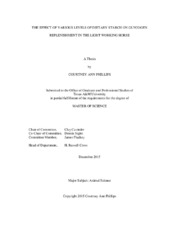| dc.description.abstract | Nine Quarter Horses (2 to 7 yr; 409 to 494 kg BW) were used in a 3 x 3 Latin square with replication study lasting 105 d to determine the effect of various levels of dietary starch on glycogen replenishment in the light working horse. Horses were fed 1 % BW/d in Coastal Bermudagrass hay with remaining calories met by a high starch (HS), medium starch (MS), or low starch (LS) concentrate. After a 7 d washout period, horses were transitioned to 1 of the 3 diets over 7 d for a 14 d treatment period where they were then worked to fatigue in a standardized exercise test (SET). Total diets provided an average of 1,206.67, 844.61, and 263.13 g of starch/d in HS, MS, and LS, respectively. Horses were lightly exercised for 30 min 3 d/wk. The SET consisted of a 30 min trot in a panel exerciser, followed by 27 min of an incremental high-intensity work on a treadmill.
Skeletal muscle biopsies were taken from the biceps femoris at rest, immediately after the SET, and 24 and 48 h post exercise. Samples were submerged in liquid nitrogen and stored at -80ºC until glycogen analysis using a commercial kit. Venous blood samples were taken at rest, immediately post exercise, 10 min after recovery, and 24 h post exercise. Data was analyzed using Proc Mixed (SAS) program.
High starch had higher resting muscle glycogen concentration (P = 0.009) than MS (10.25 vs. 8.28 μg/mg wet wt). Low starch had higher glycogen concentration 24 h post (P = 0.04) than HS (9.52 vs. 7.68 μg/mg wet wt). High starch utilized more glycogen than MS or LS. A slight reduction in glycogen post exercise for MS and LS indicated that fat or protein may have been used as substrate for exercise. Results indicated that feeding 1,206.67 g starch/d did not yield an advantage in recovery time over a MS or LS diet. Energy expenditure during the SET yielded similar (P = 0.98) blood lactate concentrations, resulting in the formation of a prediction equation of y = 0.002x^2 – 0.3102x + 6.6874. | en |


